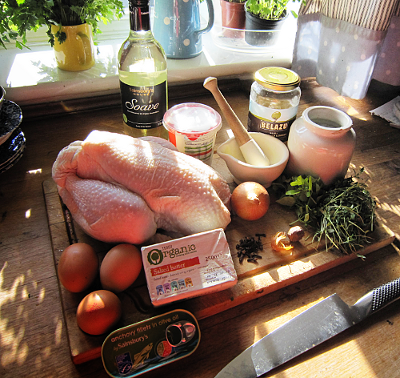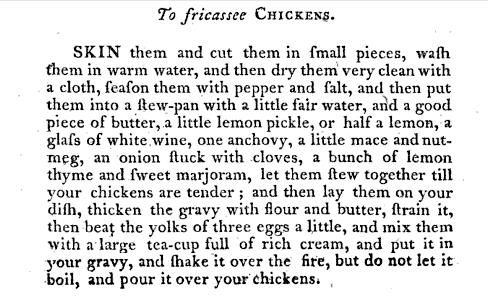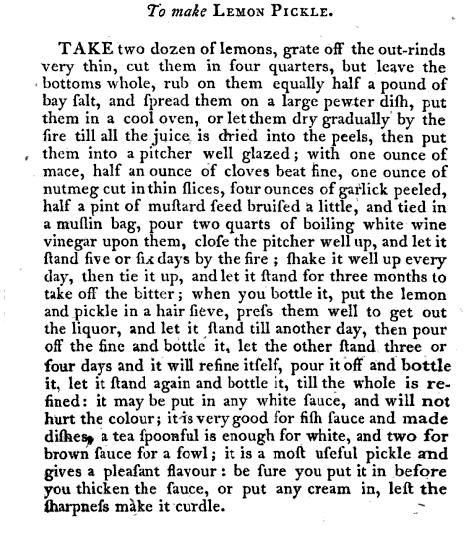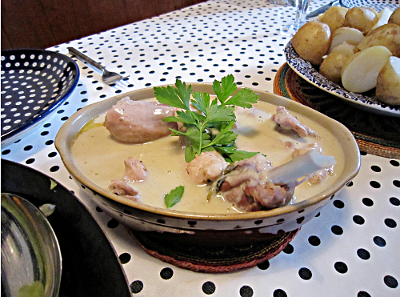It’s a bit of a risky proposition to describe over a century
of food history in one short blog post. Still, reading through the cookbooks I
can get my grubby little hands on (bless the invention of .PDF files), mostly
for and by the upper or merchant classes, there are some definite themes in the
types of food that were being prepared. There was still a strong preference for meat, where
possible, although vegetable dishes were now becoming common too. Butter and
cream featured heavily, in particular – the preference was for rich tastes, and
new kinds of sauces were made with this in mind. On British tables
specifically, melted butter or ‘butter sauce’ was used on nearly everything
that wasn’t already accompanied by sauce of its own. From Hannah Glasse, The art of cookery:
To melt butter,…melting of butter you must be very careful; let your saucepan be well tinned, take a spoonful of cold water, a little dust of flour, and your butter cut to pieces: be sure to keep shaking your pan one way, for fear it should bil; when it is all melted, let it boil, and it will be smooth and fine. A silver pan is best, if you have one.
(To clarify: Heat a little plain flour and water in a saucepan over a gentle heat until it makes a paste with no lumps, then stir in small pieces of butter until melted and smooth. Proportions don’t matter too much, but I used a heaped tablespoon of flour, about three tablespoons of water, then about 50g butter. Use common sense for larger quantities – the Georgians certainly seemed to. A pinch of salt near the end doesn’t go amiss.)
Women cooks and authors weren’t that unusual – though the
most prestigious and fashionable were certainly men, and frequently French.
I’ll talk a little more about them later on. Women writers such as Hannah Glasse
and Elizabeth Raffald were a few rungs down the social ladder, but could be
remarkable successful nonetheless. Raffald’s book The Experienced English Housekeeper went through dozens of
editions, and she eventually sold the copyright for the equivalent of £200,000
– not bad at all, for a cookbook.
Reading through some of the cookbooks that were published at
the time (many of which are available online, for the curious – see the sources
page) I was pleasantly surprised by how accessible they are, once you get used
to the writing style – although that makes sense, considering they are
instructions. Mrs Glasse wrote in 1747 that it was her intention ‘to instruct
the lower sort’, which suits me, if it keeps her instructions nice and clear.
The recipe I picked to try out, however, is one of Mrs. Raffald’s, and pretty
straightforward. Although chicken was not the cheapest of meats at the time –
they were more valuable for laying eggs, so most birds would have been either
cocks or slightly old and stringy, unless you were rich enough to afford a
young one. Veal was more common – but there are enough mentions of chicken meat
in The Experienced English Housekeeper that
I don’t feel like I’m cheating.
The style of listing the ingredients separately from the
instructions wouldn’t come in until the next century, but this dish is
uncomplicated enough to deal with without one. Mind you, I spared many a
pitying thought for cooks who had to kill, pluck and gut their birds as well
and skin and butcher them – all very well for Raffald to say ‘cut them in small pieces’!
Still, it happened, if a little messily. Here’s a slightly simpler version:
1 large chickenLarge glass white wine (the rest of the bottle belongs by moral right to the cook)Pickled lemon (can be bought from most large supermarkets, or made at home, for the enterprising.)1 anchovyA few blades of maceAbout half a nutmeg, grated finely1 medium onion, peeled and pierced with a skewer all over, and stuck with cloves (Not too many, as these are strong - five or six will do.)Bunch lemon thyme and sweet marjoram ( The thyme will need to be discarded at the end as the stalks are tough - they are, however, good for tying the bunch of herbs together in the first place.)About 50g butter, plus extra for thickeningHeaped tbsp plain flourYolks of 2 eggs (eggs were smaller then, go with me on this - also, please make sure they are very fresh - let's have no salmonella here.)Large cupful double cream - 150-200mlSalt and pepperButcher a large chicken - removing the legs and wings first by cutting between the joints, then slicing down the spine to cut away the breasts. (Yes, this is harder than it sounds, as I soon discovered: Here is a slighter better guide. Alternatively, you can go the easy route and buy individual pieces of chicken.) Rinse and dry, then rub with salt and pepper - easy on the salt. Place the pieces in a heavy pan with all the other ingredients except the flour, egg yolks, cream and extra flour. Simmer until chicken is tender and falling off the bone - a good hour. Place the cooked chicken in a serving dish, reserving the liquid, then heat the flour in the remaining butter for a few minutes and pour in the liquid again. Whisk to remove lumps, then take off the heat. Beat the egg yolks into the cream and then stir into the hot gravy until it thickens slightly. Pour over the chicken, and serve.
Ideally, this would have been served with many other dishes,
placed artistically together on the table in the style called ‘a la francaise’
– a pattern of individual dishes all served on the table together, from which
the host and guests could serve themselves. As it was, I did my best to make a
couple of dishes of potatoes, carrots and cabbages look appealing – all at
least authentic accompaniments – plus a jug of the butter sauce that was so
typical of the time. My tasters (parents
and siblings, today) seemed to approve.
Obviously, taking just one dish that
would originally have been served with many others all at once isn’t really
representative of a proper upper-class dinner of the period; but I do feel it
summed up a lot of the themes of cookery at the time. Fresh meat was the star
of the main dishes, and was cooked up with lots of velvety cream sauce flavoured
with wine, nutmeg and a hint of clove. The vegetables were enriched with lots
of butter sauce, and the whole thing was heightened by a little taste of lemon
pickle in the background – a nod to the Georgian and Regency store cupboards. Pickling and the making of pre-cooked flavourings was a
major occupation for a housekeeper; after all, few people could afford an ice
house, so preserves were a necessity as well as an acquired taste. This was the
age of ketchup (also known as ‘catsup’ or ‘catchup’) made at home from
mushrooms or walnuts – tomatoes were still viewed with some suspicion during
the most part of the 1700s, so tomato ketchup would not become favoured until
the next century. Regretfully, I did not make my own lemon pickle, despite
Elizabeth Raffald providing a recipe in the same book as the recipe for chicken
fricassee. We had a jar of pickled lemons in the fridge already, something now
used more commonly in Moroccan cooking, and after all, the idea of making
pickles in advance was for convenience as well as economy. If you want to try
it, however…
For despite the luxurious flavours and richness favoured by
Georgian cooks, few housekeepers could afford to be wasteful. Recipes such as
fricassees, ‘forcemeats’ (stuffing) or ‘olives’ (stuffed rolls of meat baked or
fried with breadcrumbs) could use leftovers efficiently, while still providing
variety – a necessity, when even small dinners frequently involved five or six
different dishes.
In the spirit of economy, never fear – the remains of my
inexpertly butchered chicken are now simmering away to make soup for later, and
smelling lovely. I think perhaps I’ll stir in the remains of the cream, and eat
it with hot buttered toast. It’s what any Georgian housekeeper would have
wanted.






No comments:
Post a Comment